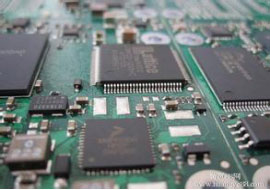
Damaged and/or lifted BGA pads on a PCB Assembly are a common problem during BGA rework. Lifted pads are most commonly the result of overheating during the rework process, and also occasionally due to poor adhesion of the pad to the base material of the PCB. Saving a PCB with lifted pads goes beyond rework and into the realm of circuit repair, a more costly, time-consuming, and complex process.
One proven solution to this problem, developed here at RUSH PCB Inc., is to modify the solder mask pattern to allow a slight overlap of the mask over the edges of the BGA pads. This slight encroachment or ‘lip’ serves as an anchor for the BGA pad, keeping it down on the PCB so that it doesn’t lift off even if its adhesion to the PCB has been compromised by overheating. This mask encroachment also provides protection for traces between the pads in addition to securing the land to the PCB. But for this approach to be effective, the size or surface area of the BGA pads must also be expanded slightly to accommodate the overlap, which should be approximately 2 mils overall.
BGA pad size can be increased by changing the PCB design to a via-in-pad approach. Via in pad makes additional PCB real estate available to increase BGA pad size on the circuit assembly. In addition to creating pad area for mask overlap, the larger pad surface area helps ensure better adhesion of the pad to the PCB assembly. Even though this change could add slightly to the cost, that additional amount would be offset by lower rework volumes, especially since rework is expensive and negatively impacts production flow.
This approach is also most effective if a smaller BGA ball size is used. This makes the maximum amount of pad area available for solder mask overlap, while at the same time leaving enough solderable pad area to form robust solder joints on the electronic assembly. In most cases, the smaller BGA sphere size can be accommodated. When this is not possible due to component-induced restrictions, then the need for additional pad size can be addressed during the initial PCB design stage.
From a PCB design perspective, the mask design modification to create the 2-mil overlap is achieved at the solder mask Gerber design stage and is created during the mask process, and is not affected by the mask application method.